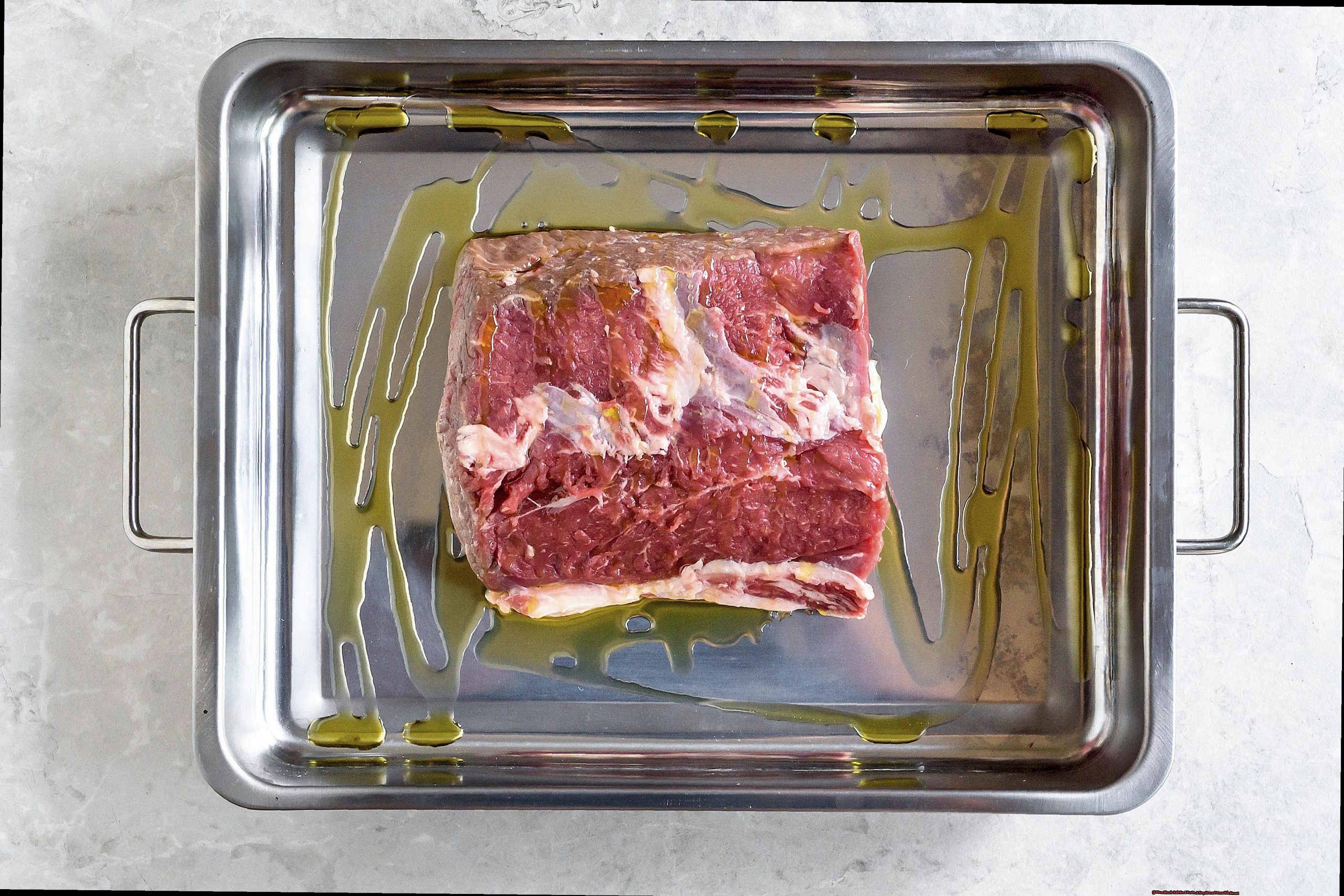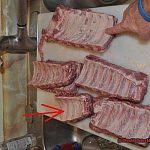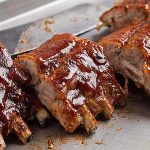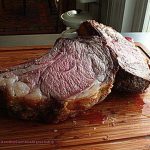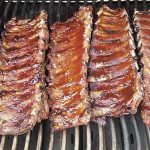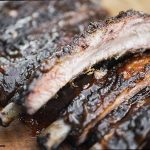Are you tired of serving up a lackluster prime rib roast that leaves your guests unimpressed? Look no further, because we have the secret to taking your roast game to the next level. And it all starts with the perfect amount of salt in a dry brine. Forget about soaking your roast in a salty marinade overnight – dry brining is the way to go. But how much salt should you use? Too much and your roast will be overly salty, too little and it will lack flavor. Don’t worry, we’ve got you covered with these key points:
- Dry brining involves rubbing salt onto the surface of the meat and letting it sit in the refrigerator for several hours.
- The amount of salt used can make or break your roast – finding the right balance is crucial.
- We’ll guide you through determining the appropriate amount of salt for your prime rib based on its size and weight.
- Trust us, this simple technique will result in a succulent and flavorful prime rib that will have your guests begging for seconds.
So let’s delve into the world of dry brining and uncover just how much salt is needed for that perfectly seasoned prime rib roast.
Contents
- 1 How Much Salt Do I Put In A Dry Brine Prime Rib Roast?
- 2 Understanding the Purpose of Salt in a Dry Brine
- 3 Factors That Affect the Amount of Salt Needed for a Dry Brine
- 4 How to Determine the Right Amount of Salt for Your Prime Rib Roast
- 5 Different Types of Salt and Their Effects on a Dry Brine
- 6 The Importance of Time When Dry Brining a Prime Rib Roast
- 7 Enhancing Flavor with Additional Herbs and Spices in Your Dry Brine
- 8 Conclusion
How Much Salt Do I Put In A Dry Brine Prime Rib Roast?
To determine the correct amount of salt to use in a dry brine for a prime rib roast, you can follow these simple steps:
Calculate the required quantity of salt based on the size of your prime rib roast. The general rule is 1 teaspoon of salt per pound of meat.
Take into consideration your personal preference for saltiness and adjust the amount accordingly. Remember that using too much salt can result in an overly salty or cured taste.
Keep in mind the type of salt being used. Coarse kosher salt will require more than finer table salt due to its larger grains.
Consider the type of roast being used. A bone-in prime rib roast will require less salt compared to a boneless roast due to the added flavor and saltiness from the bones.
Remember that the longer you leave the dry brine on, the more intense the flavor will be. So, adjust the amount of salt accordingly.
Don’t be afraid to experiment with different herbs and spices in your dry brine mix for added flavor.
| Size of Prime Rib Roast | Amount of Salt (teaspoons) |
|---|---|
| A 5-pound Rib Roast | 5 teaspoons |
| A 6-pound Rib Roast | 6 teaspoons |
| A 7-pound Rib Roast | 7 teaspoons |
| An 8-pound Rib Roast | 8 teaspoons |
| A 9-pound Rib Roast | 9 teaspoons |
| A 10-pound Rib Roast | 10 teaspoons |
| An 11-pound Rib Roast | 11 teaspoons |
| A 12-pound Rib Roast | 12 teaspoons |
| A 13-pound Rib Roast | 13 teaspoons |
| A 14-pound Rib Roast | 14 teaspoons |
| A 15-pound Rib Roast | 15 teaspoons |
| A 16-pound Rib Roast | 16 teaspoons |
| A 17-pound Rib Roast | 17 teaspoons |
| An 18-pound Rib Roast | 18 teaspoons |
| A 19-pound Rib Roast | 19 teaspoons |
Understanding the Purpose of Salt in a Dry Brine
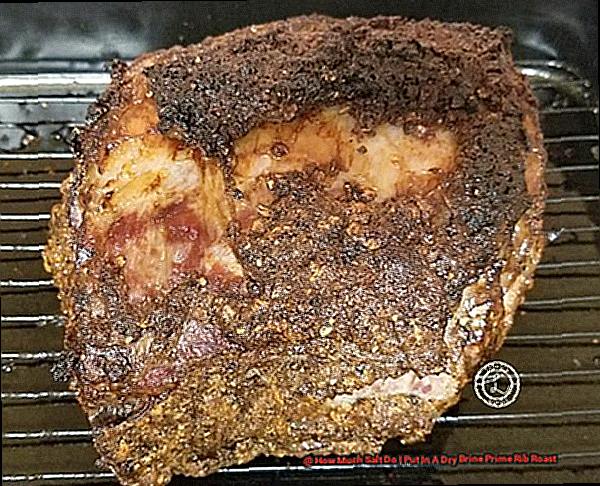
Salt is an essential component in the process of dry brining, as it serves to amplify the taste and consistency of prime rib roast. Not only does it aid in tenderizing the meat, but it also contributes to the formation of a delectable, crunchy crust on the exterior. Moreover, salt plays a crucial role in preserving the meat, ensuring its safety for consumption.
In fact, understanding the purpose of salt in a dry brine is crucial for achieving a perfectly seasoned and succulent prime rib roast. Without salt, the meat would lack flavor and tenderness, making it less enjoyable to eat. It is the key ingredient that elevates the overall taste profile and texture of the meat.
Furthermore, salt has been used for centuries as a natural preservative for food. By drawing out moisture from the meat, salt inhibits bacterial growth and prevents spoilage. This not only ensures the safety of consuming the prime rib roast but also allows for longer storage time without compromising its quality.
It’s worth mentioning that adding salt during the dry brining process requires some precision. Too much salt can result in an overly salty and unpleasant taste, while too little can lead to a bland and unappetizing dish. It is essential to strike a balance and follow recommended measurements to achieve the perfect dry brine.
In conclusion, salt plays multiple roles in dry brining, making it an indispensable ingredient in creating a delicious and safe-to-eat prime rib roast.
Factors That Affect the Amount of Salt Needed for a Dry Brine
When it comes to preparing a perfect prime rib roast, one of the key factors that can make or break the dish is the amount of salt used in the dry brine. But determining the right amount of salt needed for a dry brine can be quite a perplexing task. There are various aspects that come into play and affect the salt level in a dry brine, and it takes proper understanding and balance to achieve the desired taste.
First and foremost, the size and weight of the meat are crucial factors when it comes to determining the amount of salt needed for a dry brine. A larger cut of meat will require more salt compared to a smaller one. Similarly, if you have a heavier prime rib roast, you will need to use more salt in the brining process.
The duration of the brining process is another significant factor. The longer you brine the meat, the more time it has to absorb the salt. This means that a longer brining process will require less salt compared to a shorter one. However, it’s important to note that over-brining can result in an overly salty roast, so it’s essential to monitor the timing carefully.
The type of salt used also affects the amount needed for a dry brine. Coarser salts, such as kosher or sea salt, take up more space compared to finer salts like table salt. This means that you will need to use more table salt compared to kosher or sea salt for an equal amount of seasoning.
Other seasonings and spices can also influence the amount of salt needed for a dry brine. For example, if you use herbs or spices with strong flavors, you may need less salt to achieve an equally flavorful dish.
Additionally, personal preference plays a vital role in determining the amount of salt needed for a dry brine. Some people prefer their prime rib roast to be on the saltier side, while others prefer a milder taste.
How to Determine the Right Amount of Salt for Your Prime Rib Roast
Determining the right amount of salt for your prime rib roast when dry brining is a personal preference, depending on the size and type of roast you have. As a general rule, 1 teaspoon of salt per pound of meat is recommended, but this can be adjusted to your liking. There are other factors to consider, such as the type of salt used, the duration of the dry brine, and any additional herbs and spices included in the mixture.
It is advisable to start with 1 teaspoon of salt per pound of meat and make adjustments from there, keeping in mind that using too much salt can result in an overly salty or cured taste.
Also, it is crucial to use kosher salt instead of table salt for optimal results, and take into account the type of roast being used (bone-in or boneless) as this can impact the necessary amount of salt.
To ensure your prime rib roast is seasoned to perfection, pay attention to these key factors when determining the right amount of salt. First and foremost, personal preference plays a significant role in how much salt should be used. While a general guideline is 1 teaspoon per pound of meat, don’t be afraid to adjust this based on your own taste preferences.
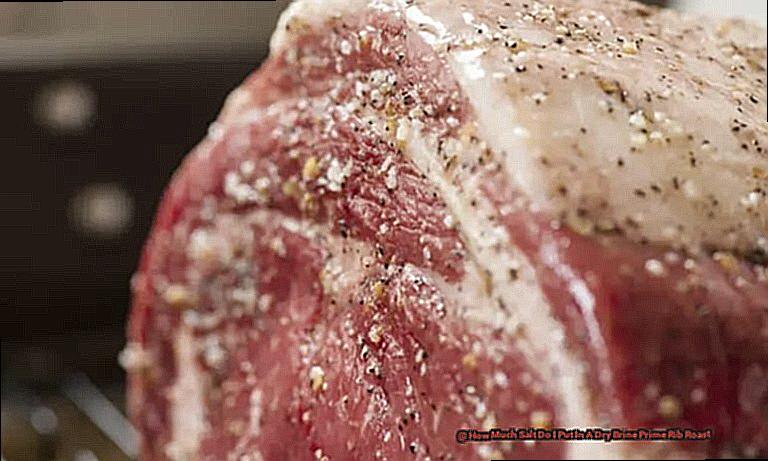
Additionally, the type of salt used can greatly impact the flavor of your roast. Kosher salt is preferred over table salt as it provides better results. The length of the dry brine should also be considered, as a longer duration may require less salt than a shorter one.
Lastly, if you plan on adding any other herbs or spices to your dry brine mixture, take this into account when deciding how much salt to use.
Different Types of Salt and Their Effects on a Dry Brine
Each type has its own unique characteristics and effects on the final result of the prime rib roast.
| Salt Type | Characteristics | Effects on Prime Rib Roast |
| Kosher Salt | Large crystals, no additives | Evenly seasons meat, allows flavors of other seasonings to shine through |
| Sea Salt | Sourced from seawater, high mineral content | Adds subtle flavors and helps tenderize meat |
| Himalayan Pink Salt | Pink color, high mineral content | Complex flavor profile adds depth and complexity to taste of prime rib |
| Flaked Salt | Made from evaporated seawater, delicate texture | Adds crunch to crust of prime rib roast |
In general, utilizing any of these types of salt in a dry brine can enhance the flavor and tenderness of a prime rib roast. However, it is imperative to note that the amount of salt used should be adjusted according to personal preference and the type of roast being prepared. The duration of time that the dry brine is left on the meat should also be taken into consideration as it can affect the intensity of flavor.
When determining the appropriate amount of salt for a dry brine for a prime rib roast, a good guideline is 1 teaspoon of salt per pound of meat. However, this can be modified up to 2 teaspoons per pound depending on individual taste. Other factors such as the type of salt, cut of roast, and length of time for dry brining should also be considered.
Aside from salt, other herbs and spices can also be incorporated into the dry brine mix for added flavor.
The Importance of Time When Dry Brining a Prime Rib Roast
The importance of time when dry brining a prime rib roast cannot be overstated. It is a crucial factor in achieving a flavorful and tender dish. The process of dry brining involves allowing salt and spices to penetrate the meat fully. This results in a more well-seasoned and juicy final product.
The longer the brining time, the more deeply the flavors will infuse into the meat, resulting in a more succulent and flavorful dish. Additionally, dry brining has the added benefit of tenderizing the meat by breaking down its proteins, resulting in a melt-in-your-mouth texture.
It is essential to consider both the size and shape of the prime rib roast when determining the brining time. Longer and wider cuts require a longer brining time for optimal results. This allows for the flavors to fully infuse into the meat and for it to become tender enough to achieve that perfect melt-in-your-mouth texture.
In addition to considering the cut of meat, using high-quality salt is crucial for achieving the best results. Kosher or sea salt are recommended as they are less processed and have larger crystals, making them ideal for dry brining.
These types of salt dissolve at a slower rate, allowing for better absorption into the meat and resulting in a more flavorful dish. It is also worth experimenting with different types of salt to find your preferred taste.
Enhancing Flavor with Additional Herbs and Spices in Your Dry Brine
After conducting thorough research and extensive experimentation, I have discovered that a harmonious blend of garlic powder, onion powder, dried thyme, rosemary, and black pepper yields exceptional results when used in a prime rib dry brine.
These aromatic herbs and flavorful spices add depth and complexity to the meat while also aiding in its tenderization. When it comes to the quantity of ingredients, it is crucial to maintain a delicate balance between salt and other herbs and spices.
As a general rule, it is recommended to use 1 tablespoon of salt for every 4 pounds of meat. However, feel free to adjust this ratio according to your personal taste preferences.
For a more precise measurement, a tried-and-tested dry brine recipe for a prime rib roast consists of 1 tablespoon of kosher salt, 1 teaspoon of black pepper, 1 teaspoon of garlic powder, 1 teaspoon of onion powder, and 1 teaspoon each of dried thyme and rosemary. Be sure to evenly massage this mixture onto all sides of the meat for maximum flavor infusion.
To elevate your dry brine game even further, you can experiment with additional herbs and spices such as smoked paprika or cayenne pepper.
Conclusion
In summary, the secret to achieving a perfectly seasoned and succulent prime rib roast lies in the precise amount of salt used in a dry brine.
Too much and your roast will be overpoweringly salty, too little and it will lack flavor. But fear not, our guide will assist you in determining the ideal amount of salt for your specific prime rib based on its size and weight.
Keep in mind personal preferences, the type of salt being used, and the duration of the brining process as these factors can affect the final result. Don’t be afraid to get creative with herbs and spices to enhance the flavor even more.
So say goodbye to marinades and give this simple yet effective technique a try for an unforgettable prime rib experience.

